#laurel thatcher ulrich
Text
Well-Behaved women seldom make history - Laurel Thatcher Ulrich
#words#Laurel Thatcher Ulrich#Arya Stark#Daenerys Targaryen#Arianne Martell#Brienne of Tarth#The rule breakers#Challenging the status quo#asoiaf
29 notes
·
View notes
Photo


pop distortion
Well-Behaved Women Seldom Make History
The famous slogan actually isn’t about bad girls in history.
It began as a phrase in a scholarly context before it moved into popular culture”
Laurel Thatcher Ulrich, women’s history pioneer, published a paper in 1976 about Puritan funeral services.
“That’s why details matter….Details help us understand the precise circumstances that allowed Artemisia Gentileschi to become an artist, or Harriet Jacobs a writer. Details keep us from falling into the twin snares of “victim” history” and “hero history.” Details let us out of boxes created by slogans.”
https://patricktreardon.com/book-review-well-behaved-women-seldom-make-history-by-laurel-thatcher-ulrich/
In reality, Laurel Thatcher Ulrich’s 2007 book of history, “Well-Behaved Women Seldom Make History” examines a pivotal moment in the lives of three women in which they broke with conventional behavior in order to re-create themselves and make a place in history. Christine de Pizan, who lived in a 15th c. French court and included Amazons in “The City of Ladies,” a book of women’s biographies. Elizabeth Cady Stanton, a 19th century suffragist when she encountered a runaway slave that helped shape her position on women’s suffrage; and Virginia Woolf, 20th century writer who created Shakespeare’s gifted, imaginary sister and her trials as a female writer.
Ulrich explains that well-behaved women should make history - Harvard.Gazette, 2007
Well-behaved women do make history, we’ve just been looking in the wrong places. - American Association for State and Local History
Popular Culture: Cognitive Biases Make Common Sense Neither
Pop Culture Is Distorting Our Priorities. February 8, 2019 Angel Diaz:
The power that pop culture has gained is insane. It is interesting that a construct of humanity has been able to dictate what is prioritized, changing our priorities in the process. Conversations about the real world and its issues are no longer the norm. Instead, discussions about who wore what to the Met Gala are more prominent. This is a huge problem that needs to be solved. If not, what society will we be living in: the digital or the physical?
Staying true in a fake world:
Does truth matter? The answer is unequivocally yes.
What makes great art great, is simple – an unbending, unyielding, uncompromising pursuit of truth. Across the huge span of mediums, at every turn the creations that prevail are laced with universal truth and purity of intent. The openness of Picasso’s mind, the tonal perfection of a Stradivari violin or the sublime balance of a Japanese haiku poem.
https://wearepath.com/path-opinion-staying-truth-fake-world/
The Return To Real: When Everything Becomes Artificial, We’ll Demand Authentic
https://armano.medium.com/the-return-to-real-when-everything-becomes-artificial-well-demand-authentic-81966d40e68
eucanthos’ image mix & research
Mata Hari wearing only a gold jeweled breastplate, 1906 post by aiiaiiiyo
Shelley Fabares I'm Evil, 1965 mixed w Ulrich’s phrase found meme
#well-behaved women seldom make history#Laurel Thatcher Ulrich#research#quotes#fake#history#women#mistakes#pop#culture#reality#Mata Hari
7 notes
·
View notes
Text
0 notes
Text
Well-behaved women rarely make history.
Lola to Babs Bunny
1 note
·
View note
Text
Apropos Hunger Games thought for International Womens Day
So I'm rereading the Hunger Games books lately (with the TBOSAS movie out on DVD I'm going back to the originals) and I happened to start Catching Fire on March 8. This felt fitting not only because of the strong female lead but also due to content of an early scene. Katniss visits Hazelle and Mrs. Hawthorne's importance to sustaining the family after the mine explosion is emphasized, compared to the general emphasis on Gale's hunting and in contrast to Gale not wanting victor Katniss' help. (that's clearly foolish pride on Gale's part, but I'm not sure to what extent it's jealousy of Everlark versus something else like not wanting Capitol blood money) I'm reminded of the Laurel Thatcher Ulrich line "well behaved women seldom make history." - that's often taken to mean if you want to be famous, be rebellious (what Katniss stumbles into in this analogy) but in context it's a lament that the chronicles downplay the efforts of ordinary people (Hazelle Hawthorne in this example)
12 notes
·
View notes
Text
💋"𝑾𝒆𝒍𝒍-𝒃𝒆𝒉𝒂𝒗𝒆𝒅 𝒘𝒐𝒎𝒆𝒏 𝒔𝒆𝒍𝒅𝒐𝒎 𝒎𝒂𝒌𝒆 𝒉𝒊𝒔𝒕𝒐𝒓𝒚."💋



-Laurel Thatcher Ulrich
19 notes
·
View notes
Note
Can you talk about the history you studied? Are there any examples of gender discrimination?
Hi, I'm not sure what you're asking here? I haven't studied history at an academic level if that's what you mean, and as such, I can't talk about any examples in the field if that's what you're asking.
In terms of the history I've been interested in and researched myself... I've been interested in Ancient Egypt, specifically the New Kingdom, the Salem Witch Trials, Australian colonial history and, of course, the late medieval period, most specifically from say, the reign of Edward II to the end of Henry VI's reign. Yes, there are examples of systematic gender discrimination in all those cases, often at a systematic or societal level. I could talk about the structures of power in Ancient Egyptian generally being the purview of men, the way women, particularly subversive women, were often targetted by witchcraft accusations, the limitations of women's roles in society... I would advise you, however, that this is such a broad question that you would be better off reading a book on the subject of women and/or gender in that particular society.
Here are some book that might be helpful, though there's a wide range of time periods:
History Matters: Patriarchy and the Challenge of Feminism, Judith M. Bennett
Woman Defamed and Woman Defended: An Anthology of Medieval Texts, ed. Alcuin Blamires
The Oxford Handbook of Women and Gender in Medieval Europe, ed. Judith M. Bennett
Between Pit and Pedestal: Women in the Middle Ages, Marty Williams and Anne Echols
Goddesses, Whores, Wives and Slaves: Women in Classical Antiquity, Sarah B. Pomeroy
Good Wives: Image and Reality in the Lives of Women in Northern New England, 1650-1750, Laurel Ulrich Thatcher
Damned Women: Sinners and Witches in Puritan New England, Elizabeth Reis
Depraved and Disorderly: Female Convicts, Sexuality and Gender in Colonial Australia, Joy Damousi
Women In Ancient Egypt, Gay Robins
#asks#anon#if you're the same anon that has sent me other asks both here and on my lancastrian sideblog#it'll be awhile before i respond to them#please be patient with me
13 notes
·
View notes
Note
Top five favorite books and or fics ?
ooooo thank you evil question im gonna do books AND fics bc i love to proselytize :))) both in no particular order because picking just five is hard enough
books:
- moby dick by herman melville. truly one of the funniest wildest most fascinating books ive ever read. feels like playing tag with herman melville. i often think about how much more delightful it would be if i was operating with an 1851 set of pop culture references bc i could tell like 2/3 of the jokes were going over my head (if anyone has context for the running joke about tall kentuckians pls hit me up).
- ghost wall by sarah moss. hauntingggggg. haunting as hell. i think about it often
- postcards by annie proulx. im a proulx completionist and i do think this is her most delightful book prosewise (close range is a close second i would not describe it as delightful but its def masterful. two for one. everybody go read proulx.)
- wolf hall by hilary mantel. rip hilary the goat no one else should ever have bothered writing historical fiction. i love this whole trilogy (you already know the end! he gets beheaded! and it works so well!) but the first one is the weirdest and the most ambitious and my favorite.
- the age of homespun by laurel thatcher ulrich. yeah its a dense tome about early new england material culture. yeah it quantifiably changed the trajectory of my life. its LAUREL
fics:
raajenboagen by oplopanax (hockey rpf) the definitive omegaverse and the definitive historical au and the definitive romance. highly recommend if you like deeply thoughtful religious and cultural worldbuilding with your omegaverse or if you, like me, were obsessed with prairie blizzards as a child
soldier’s heart by alex51324 (downton abbey) i literally wrote a whole explainer one time on how much i love this fic. just finished my yearly reread, it still fucks
stretch out your hand, my captain by thegooddoctor (the terror) killer writing about gender and historical queerness and repression and also prose so good i genuinely think about it all the time
jeeves and the club for inverts by triedunture (jeeves & wooster) i am realizing that all these are historicals. oops well i like what i like. anyway anyone who can do wodehouse pastiche this good is a national treasure
down by the brazos by ionthesparrow (hockey rpf) you guys know that thing where the setting is a character. this does that for gulf coast texas, a place i have never been, in a way that makes me literally able to smell the water
#ask game#long post#if anybody reads any of these you have to come tell me#i am FROTHING at the MOUTH to discuss these#which was my criteria for picking favs there are probably a million more that i could put on these lists
11 notes
·
View notes
Text
New episode, and a non-standard format. The Tournament is an event we do every so often where we send characters from the various texts we've read on listener-submitted Quests -- or, to use the Tumblr vernacular, we put Blorbos in Situations.
Listeners can vote on whose approach to each Quest is better at the link below, active until May 13, 2024.
We also do some Q&A.
-----
It's our 100th episode! Come celebrate with us as we host our second tournament - Mac and I compete with each other to see who has the best approach to listener submitted quests, with parties compiled of the characters we've collected from each episode.
Special thanks to all the listeners who submitted quest ideas and questions for us to answer!
WHO WON? VOTE HERE!
Check out our Kickstarter!
Join our discord community! Check out our Tumblr for even more! Support us on patreon! Check out our merch!
The Beastiary Challenge! (<-- Don't miss it!)
Socials: Tumblr Website Twitter Instagram Facebook
Citations & References:
Ulrich, Laurel Thatcher. “Vertuous Women Found: New England Ministerial Literature, 1668-1735.” American Quarterly, vol. 28, no. 1, 1976, pp. 20–40.
Richard Keikhefer, Magic in the Middle Ages & Forbidden Rites - find both here!
Bailey, Michael D. ‘The Disenchantment of Magic: Spells, Charms, and Superstition in Early European Witchcraft Literature.’ The American Historical Review, Vol 111, No. 2. April 2006. pp. 383-404.
—. ‘The Age of Magicians: Periodization in the History of European Magic.’ Magic, Ritual, and Witchcraft, Vol. 3. University of Pennsylvania Press, 2008. pp. 1-28.
—. ‘The Disenchantment of Magic: Spells, Charms, and Superstition in Early European Witchcraft Literature.’ The American Historical Review, Vol. 111, No. 2. University of Pennsylvania Press, April 2006. pp. 383-404.
5 notes
·
View notes
Quote
Well-behaved women seldom make history.
Laurel Thatcher Ulrich
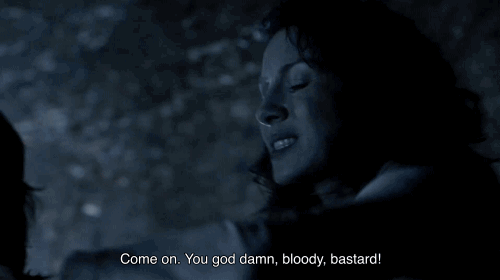
112 notes
·
View notes
Note
Layla for the character aesthetic meme?
Layla Aldori, Wrath of the Righteous
Flame Dancer Bard, Mythic Demon
Playlist
"Layla" - Derek & The Dominos
"Maneater" - Daryl Hall & John Oates
"Psycho Killer" - Talking Heads
"Evil Woman" - Electric Light Orchestra
"Poison" - Alice Cooper
Moodboard

Steal Their Look
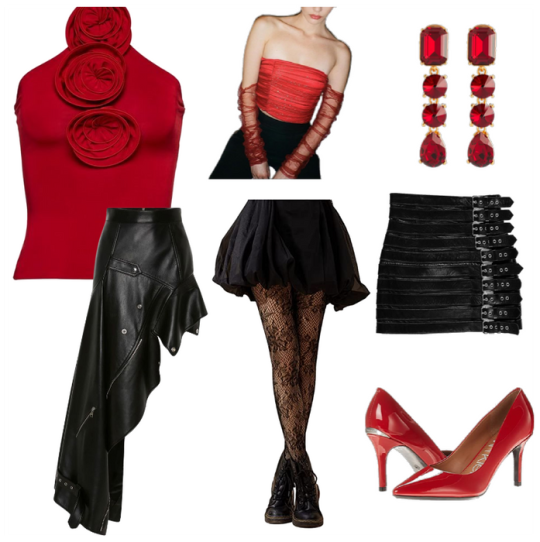
Quotes
"Well-behaved women seldom make history." - Laurel Thatcher Ulrich
"I think the devil will not have me damned, lest the oil that's in me should set hell on fire." - William Shakespeare
“The Knight of Courage turns his back to you, Sigoso Vetalda,” he said, voice quaking… “Damn you to the Womb of Fire.”
Sigoso smiled. “I am there,” he said, “and it is paradise.” - Samantha Shannon
“There were many beautiful vipers in those days and she was one of them." - Mary Elizabeth Braddon
Aesthetic
Fresh bruises turning yellow | Red lipstick on wine glasses | The clack of stilleto heels on pavement | The taste of blood as you bite your lover's lip | Roaring flames of a gasoline fire
character aesthetics meme
8 notes
·
View notes
Text
memety meme meme
Tagged by the wonderful @anghraine <3
Rules: answer the questions and tag 9 people you want to know better.
last song I listened to: "Solitude" (1990 Remaster) by Duke Ellington & Louis Armstrong
currently reading: A Midwife's Tale by Laurel Thatcher Ulrich, for class on Wednesday. I read this in 2020 first and I look forward to diving in again!
current watching: DropoutTV bangers such as Make Some Noise & Game Changer & Very Important People
currently obsessed with: my D&D campaign, Xóan's Legacy, which you can learn all about here.
tagging: @theemightypen @kareenvorbarra @croclock @jobean12-blog @marvelgirl7 @alliluyevas @an-old-lady @nobodysuspectsthebutterfly
3 notes
·
View notes
Text

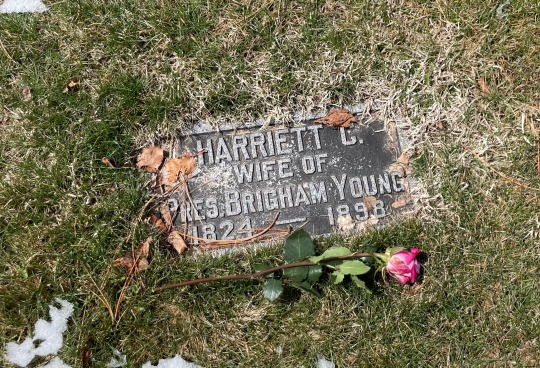

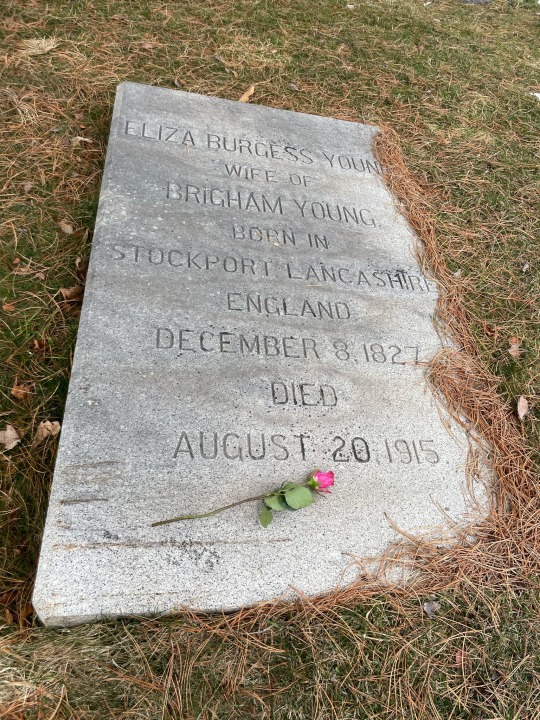
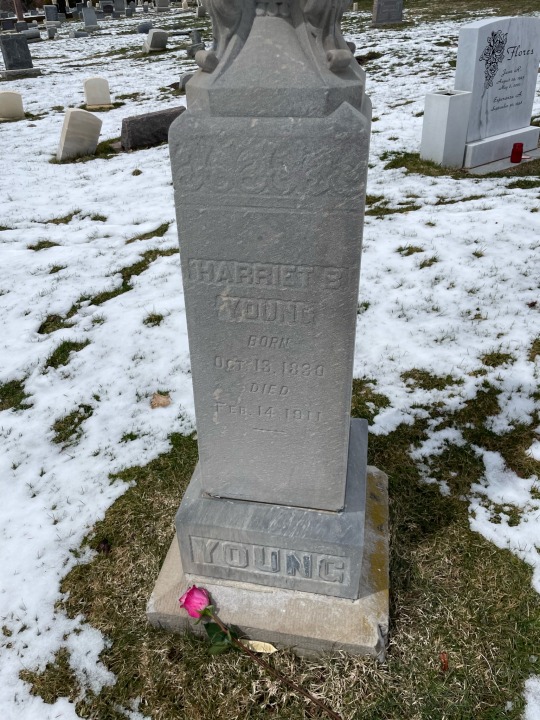

I mentioned earlier that a lot of Young family members are scattered around the Salt Lake City cemetery in a few different sections, so I thought I'd share the graves for some of the women I don't know as much about in a post together. Aside from Emily Partridge and Zina Huntington, who I'll make a separate post for in a bit, these are all the wives of Brigham Young I located in the SLC cemetery (ie, not buried with him in the family graveyard). I put the pictures of both the graves and the women in chronological order of when they married into the family, which also (roughly) tracks with their age.
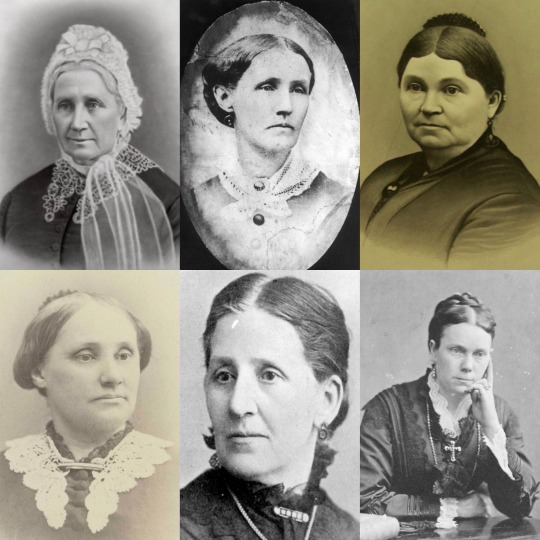
Augusta Adams Cobb (1802-1886) lived in Boston with her first husband and nine children before being converted to Mormonism by Brigham Young when he was a missionary in Massachusetts. She ended up leaving her first husband and her older children to move to Nauvoo with her two youngest and become Brigham's second plural wife. They were about the same age and she did not have children with him. The marriage proved rather fraught, as she wrote him numerous letters complaining with quite caustic language about him paying more attention to younger wives. They did stay married, although he eventually agreed to allow her to unseal from him and seal herself to Joseph Smith for eternity. Twenty-five years later, her son James's ex-wife Mary van Cott ended up becoming Brigham's second-to-last wife. When Augusta died, she was initially buried according to her wishes with Brigham, but her daughter Charlotte, who had left Mormonism as an adult, later had her exhumed and she is now buried with James, Charlotte, and Charlotte's husband. You'll note that Augusta's current gravestone does not mention Brigham Young at all--I'm assuming that was probably Charlotte's choice as well.
Harriet Cook (1824-1898) (identified on her grave as Harriett C.) was Brigham Young's third plural wife and the last woman he married before Joseph Smith's death. I don't know a lot about her except that virtually every reference I've found to her involves other women talking about her being difficult to get along with and irritable, though there's also references to her being brave and intelligent. Apparently, she told a sister-wife that she was "only a proxy wife" and Brigham didn't love her. I don't get the sense that she was a particular favorite either, so I tend to interpret her behavior as someone who was unhappy with her situation trying to "punch down" on wives she viewed as being worse off than her. She had one son, Oscar, who she is buried next to.
Clara Decker (1828-1889) was the younger sister of Lucy Decker, Brigham's first plural wife. She married him in 1844 when she was fifteen. I don't know a lot about her life or personality, unfortunately. Her obituary refers to her as "of a very modest and retiring disposition". Clara, like many other women whose life was primarily in the sphere of the home and who did not leave much if any personal writing, is hard to find traces of in the historical record. (Very much women's historian and fellow Mormon Laurel Thatcher Ulrich’s "well-behaved women rarely make history"). As her gravestone and much of the contemporary writing I can find about her tells us, she was one of three women who accompanied the vanguard pioneers into the Salt Lake Valley in 1847. The other two women were wives of Heber Kimball and Brigham's brother Lorenzo Young. Again, we don't know what Clara thought or felt about this journey, but I imagine traveling to an unknown new home as a nineteen-year-old in a company of over 140 men led by her husband must have been a bit of a strange experience. She is buried next to her daughter Jeanette and near her two other daughters. She also had two sons who did not live to adulthood.
Eliza Burgess (1827-1915), unfortunately, I do not know a lot about either. Eliza immigrated from England to Nauvoo with her family and worked in the Lion House as a servant before marrying Brigham at age 25. Her stepdaughter Susa Young, who wrote a fair amount about her childhood in the Lion House and is one of the only sources on the personality of some lesser-documented wives, described her as a "capable, efficient housewife" and said that "her one release from what might have been corroding jealousy in a lesser soul was driving labor", which is frankly pretty depressing. Susa also described Eliza as a doting mother to her only child, Alfales. As an adult, Alfales was editor of a Mormon-critical paper and was one of two children of Brigham Young who I know outright left the church. Eliza lived with him after being widowed until her death, and he is buried next to her. She was Brigham Young's last surviving wife. Interestingly, there's a photograph taken of Brigham's other seven living wives in 1899, but for some reason Eliza was not included (maybe because of her son's outspoken religious views?)
Harriet Barney (1830-1911) first married at the age of sixteen as the third wife of 31-year-old William Sayers, though their first child was not born until about five years later. She left Sayers after four children and remarried Brigham Young in 1856. (Though both her marriages were polygamous, single mothers, whether divorced or widowed, were disproportionately likely to be in plural marriages if they married again.) She had one more child, Phineas Young, who she is buried next to. Susa Young described her as a "calm, peaceful soul" who was friendly with her sister-wives even though she did not live in the Lion House, which was already fully occupied by the time she married into the family. Her obituary implies that she had suffered from some sort of chronic illness for 40 years by the time of her death.
Finally, we have the third woman named Harriet that Brigham Young married, generally known to historians as Amelia Folsom--she started going by her middle name after her marriage to distinguish herself from the two other Harriets. Harriet Amelia (1838-1910) married 61-year-old Brigham in 1863, and was his undisputed favorite wife until his death. She was the oldest child of church-employed architect William Folsom, apparently a talented pianist and singer, described by contemporaries as charming and fashionable, and frequently accompanied her husband to dances and the theater. As he aged and developed various health problems, she also provided him comfort and companionship at home, including at his home in southern Utah, where he spent the last several winters of his life with just Amelia. She seems to have been liked by some of her sister-wives and resented by others. She never had children--I'm guessing she was not able to, because he had children with other women after their marriage. Still in her thirties when she was widowed, she was left a significant bequest. She ended up spending some time living with her elderly father as his caregiver (like her husband, he suffered from arthritis), and then purchased her own home, where she taught piano lessons and entertained until being disabled by a stroke three years before her death.
The only one of these women who left much of anything in her own words was Augusta, so there's definitely a process here of guesswork when you try to reassemble what these women and their lives might be like, working off the reminiscences of co-wives, stepchildren, children, and public memory.
#i'm intrigued by the placement of Amelia's grave bc she evidently chose not to be buried with brigham but she also didnt have kids to be#buried with and she's not near her parents or siblings either#or sister wives she's sort of like...by herself.#again like i have no idea how she felt about her husband or if she was sad she didn't have kids or if she felt like she was living her best#life as a financially stable widow who owned her own home and taught piano. but she kind of makes me sad :(#i sought her out bc i wanted to give her a rose. everyone else in this post i sort of stumbled across while looking for emily partridge#Mormonposting tag#julia in utah 2023
7 notes
·
View notes
Text
"well-behaved women seldom make history"
- Laurel Thatcher Ulrich
2 notes
·
View notes
Text
Finding all the names of women who supported the anti-suffrage cause is really important to me because I can sometimes hunt down more information on them and learn about their lives. Many suffragettes have books on books about them, but sometimes all I find on antis are their writings and then a gravestone. The main figures have whole Wikipedia pages on them, but even then there’s less information than I’d like to see.
When I find more about these conservative women, I can see the lives of what Laurel Thatcher Ulrich called the “well-behaved women” that don't often make history. It looks like the antis who held local, non-political positions to help working moms and children, support victims of WWI, encourage historic preservation, and much more.
Others focused heavily on education, whether it be receiving an education, becoming teachers, or writing many, many books. Some others lived a bit more quietly, educating their children themselves or supporting them as they went to public school, caring for or working alongside their husbands, and managing their home while supporting antis as a hobby of sorts.
I’ve also learned about how odd these women could be, given that all I known of them before was the assumption that they were all old, stuffy, and quiet. Many antis could be reserved, like Madeleine Dahlgren, who once only sent a written letter to Congress on the issue of suffrage while suffragists were there to speak. But other antis, like Mary Wilson Thompson, were much more outgoing and aggressive in their activism. Thompson once asking a politician she knew to send out 260 thousand pieces of anti-suffrage literature to West Virginia and chased down a politician demanding he sign a statement that would let her act on his behalf during the attempt ratification of the 19th Amendment. When speaking for her cause against suffragists, which would end in her victory, as Delaware would not ratify the 19th Amendment, antis lifted her chair and paraded around with her when they won two decisive votes.
All I knew of these conservative women were their “negative” and “weak” qualities. Because of that, I couldn’t have seen their conditions as anything other than sad and powerless. But the truth is that whether they were “well-behaved” or ambitious, lived quietly or did much, conservative women of the past were just as unique, influential, and happy as we consider the average woman today. Our standards back then may have been different, but that doesn’t mean women lived the uniform lives we assume they did.
#I feel like there’s more to say but I’ll leave it at this because I really just wanted to share what conservative women were really doing to#Help kill off the stereotype that they were all weak stuffy and restricted#Women of the past were just like us!#anti suffrage#commentary#traditional femininity
3 notes
·
View notes
Text
Previously my main reference for material culture as women's history was Laurel Thatcher Ulrich, who is one of the best women's historians, imo. But she very much takes women's interiority, social position, and patriarchy very seriously. This is the first time I have read a book by a textile historian, and it is so clear that the beauty and craft of the textile art, and the culture around that, are her priority, and the lives and suffering of the women who created and wore this art is a secondary concern. It's a very uncomfortable reading experience.
5 notes
·
View notes